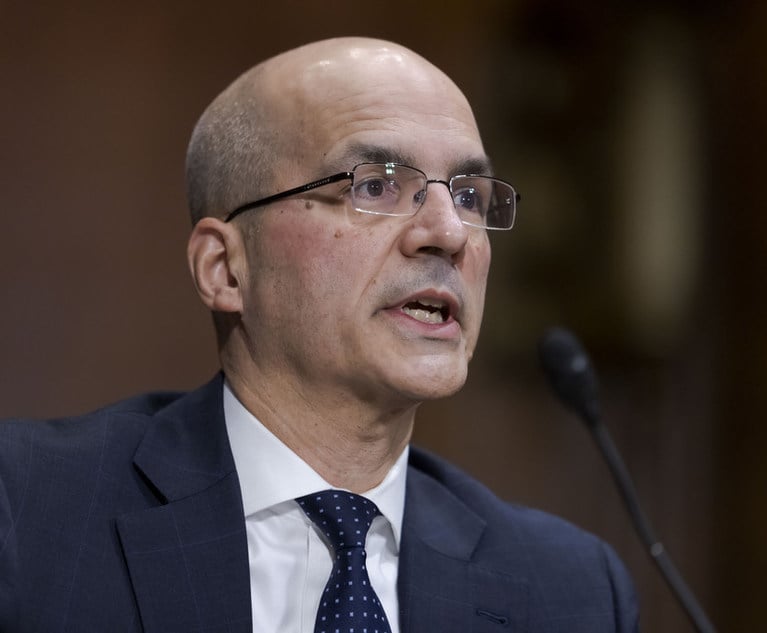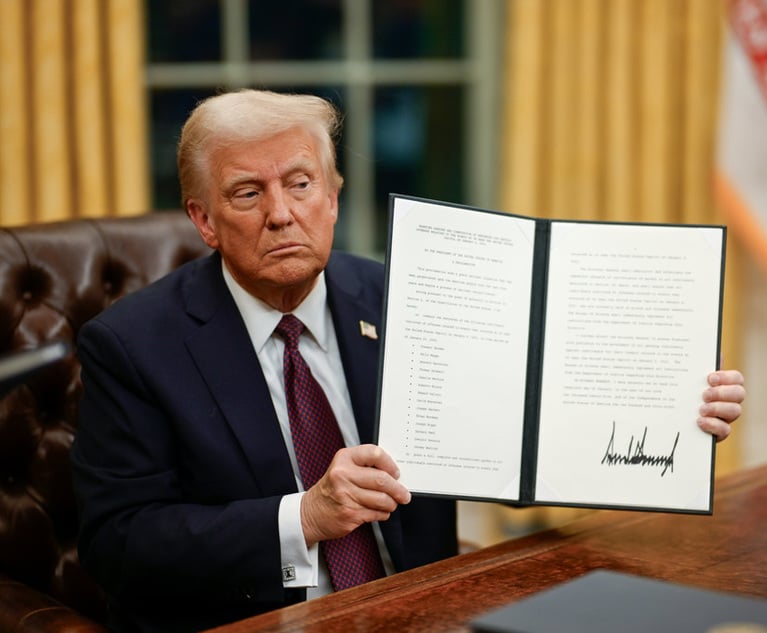Wills in the Digital Age
Is an e-will, which exists only in a computer file, just a manifestation of another technological advance than can be accommodated by our statute of wills, or does it really test the boundaries of the law?
March 06, 2018 at 02:35 PM
9 minute read
 A column in the New York Law Journal in 1977 titled "Wills in the Mechanical Age" discussed the then novel question of whether a photostatic reproduction of a testamentary instrument complied with New York's statutory requirement that it must be "in writing."
A column in the New York Law Journal in 1977 titled "Wills in the Mechanical Age" discussed the then novel question of whether a photostatic reproduction of a testamentary instrument complied with New York's statutory requirement that it must be "in writing."
The simple answer was that the means of preparation of the document were not determinative. Rather, it was its purposeful adoption as an original by the testator that controlled.
Little did the author of the column envision that 40 years later she would consider the admissibility of a will in the electronic age.
Is an e-will, which exists only in a computer file, just a manifestation of another technological advance than can be accommodated by our statute of wills, or does it really test the boundaries of the law?
There is a myriad of questions raised by such a will. It is noted that only Nevada has a comprehensive statute governing such wills; the governor of Florida recently vetoed such a proposed electronic wills statute. But three state courts have addressed the issue namely Tennessee, Ohio and Connecticut. All three states have statutes governing the execution of wills that are very similar to New York's EPTL 3-2.1 that requires a writing signed or acknowledged by the testator in the presence of at least two witnesses who also must sign the document. The Ohio court admitted to probate a will prepared on a tablet computer and signed by the testator and the witnesses by using a stylus to write directly on the device's screen. In re Estate of Castro, 27 Quinnipiac Prob. L.J. 412 (2013). The Tennessee intermediate appellate court affirmed the admission to probate of a will written with a word processing program and signed by both the witnesses and the testator typing their names at the end of the document. Taylor v. Holt, 134 S.W.3d 830 (Tenn. Ct. App. 2003). In Connecticut, the Superior Court affirmed the denial of probate to a document that had been prepared online using a commercial service, printed, but never signed by the decedent, and rejected the argument that the decedent's online confirmation of the document prior to making payment by credit card amounted to a signature, noting that even if it could be considered a signature, it did not appear on the will. Litevich v. Probate Court, Dist. of West Haven, 2013 Conn. Super. LEXIS 115).
Some of the questions raised by electronic wills are not surprising. How is the will executed? How is the will securely stored and, relatedly, how is the integrity of the document assured? How is an electronic will revoked? How is the will admitted to probate? Others are perhaps less obvious. Allowing the creation of electronic wills is likely to encourage "do it yourself" estate planning with all the difficulties that can create. On the other hand, it appears to be impossible to discourage the urge to create a will without professional help.
Assuming that the electronic will must be signed by the testator, how is that signature to be made? There are several possible methods, some relatively simple. A testator could scan a handwritten signature, crop the image, and then paste the scanned signature into the digital will. If the testator uses software and hardware that allows the testator to write on the screen of the device with a stylus, the testator can directly sign, or the testator could type the testator's name at the end of the document. In either case, if there are witnesses who sign the document in some way, there is a strong argument that the execution ceremony fulfills the Statute of Wills. Such signatures would comply with the definition in the Federal E-Sign Act, which defines an "electronic signature" to be "an electronic sound, symbol, or process, attached to or logically associated with a contract or other record and executed or adopted by a person with the intent to sign the record."
There are more sophisticated ways of affixing an electronic signature to an electronic document involving encryption which results in a digital signature that are commercially available from various providers. It appears that electronic signatures may be as easy to create as signing a traditional will with pen and ink.
If the witnesses and the testator are in the same physical space when the testator affixes an electronic (or digital) signature to the electronic will, they have "witnessed" the same way the witnesses to the testator's signature on a hard copy will have witnessed. If they then affix their electronic (or digital) signatures to the will, the requirement of attestation is fulfilled. The interesting questions arise when the witnesses and the testator are not in the same physical space but are connected by electronically provided audio and video. Think of will execution using e-conferencing software where the testator and the witnesses, and a notary if the will is to be self-proved, can all see and hear each other and the document and watch as the signatures are added to the document.
Whether or not this sort of presence should be sufficient to fulfill the presence requirement of the Statute of Wills depends, of course, on the purpose of that requirement, which is the prevention of fraud. The dead cannot speak for themselves and the living need to be as sure as is reasonably possible that the dispositions contained in the testator's will are what the testator wanted. (And even then, the perfectly executed will may be tainted by undue influence, fraud, or lack of capacity.) A common hypothetical used by both authors in their law school classes involve the testator who tries to execute the will over the phone: The testator signs, some trusted person then delivers the document to a witness who calls the testator and says "I see your signature on this document that I will now witness for you." The problem, of course, is that the testator has no idea what the witness is looking at. Now that technology allows several people to look at the same document and each other, whether or not they are physically present to each other, the idea of remote execution and attestation is not so easily dismissed.
Questions do remain, however. For example, how much do the witnesses see of the testator's surroundings? Is there someone out of camera range whose presence might be an indication of undue influence or even more dramatically, who is threatening the testator? Presumably, it will not be enough for the witnesses to see only the signature page and the attestation clause'—given the malleability of a word processing file, perhaps the testator must electronically sign each page in the witnesses' presence, however defined, which in turn compromises the privacy of the document. If the will is to be self-proved, the notary must somehow be satisfied of the identity of the witnesses and the testator, a process that may be as simple as holding up to the camera a driver's license or other government issued photo ID. Of course, the same requirement might apply to the witnesses and the testator who would identify themselves to each other.
How is such a will revoked? A paper will can be revoked by destroying with the intent to revoke. Does deletion of the file containing the electronic will count? And how will we know if the testator did the deletion? Perhaps the only safe way to revoke an electronic will without making a new will is by a subsequent document executed in the same manner as the will. Revocation by physical act may become obsolete.
Finally, how is the electronic will to be stored and retrieved? The e-will written by the testator using a word processing program and signed by the testator and witnesses by typing their names, writing with a stylus, or using a more sophisticated digital signature, with simple electronic device will have to be produced after death. That task will probably fall under the provisions of the laws governing fiduciary access to digital assets (with all of its problems). Perhaps the venerable proceeding to open a safe deposit box to search for a will in SCPA Article 20 may have to be updated to include a search of the decedent's devices. The will could be downloaded to a flash drive, but then the flash drive must be kept safe and may become the subject of a postmortem search. If the flash drive or the document is encrypted, we have to hope that the testator leaves behind the password, somewhere.
If some third party stores the will, problems of security and privacy arise. The newly revised Nevada statutes require a "qualified custodian" to store the electronic will in a "system that protects electronic records from destruction, alternation or unauthorized access and detects any change to an electronic record." In addition, the custodian must store the will with a visual record of the testator and witnesses taken contemporaneously with the execution and a visual record of the documentation of the identity of the testator and the witnesses. Will those visual records be part of the probate proceeding or at least discoverable if probate is contested? Images of a testator weakened by illness may be very useful to those contesting a will even if the testator arguably has testamentary capacity. If the electronic will is somehow lost, will it be possible to admit to probate an unsigned a hard copy under the usual lost will rules?
The Uniform Laws Commission has appointed a committee to draft a uniform electronic wills act, in part because it appears that the electronic will is inevitable. Perhaps it is. But the problems it raises are not very different from those that for centuries have complicated the disposition of property after the owner's death. Stay tuned for the next chapter.
Renee R. Roth is former a Surrogate, New York County and of counsel to McLaughlin & Stern. William P. LaPiana is Associate Dean and the Rita and Joseph Solomon Professor of Wills, Trusts and Estates at New York Law School.
This content has been archived. It is available through our partners, LexisNexis® and Bloomberg Law.
To view this content, please continue to their sites.
Not a Lexis Subscriber?
Subscribe Now
Not a Bloomberg Law Subscriber?
Subscribe Now
NOT FOR REPRINT
© 2025 ALM Global, LLC, All Rights Reserved. Request academic re-use from www.copyright.com. All other uses, submit a request to [email protected]. For more information visit Asset & Logo Licensing.
You Might Like
View All
'Serious Legal Errors'?: Rival League May Appeal Following Dismissal of Soccer Antitrust Case
6 minute read
How Some Elite Law Firms Are Growing Equity Partner Ranks Faster Than Others
4 minute read
Trending Stories
- 1PayPal Faces New Round of Claims; This Time Alleging Its 'Honey' Browser Extension Cheated Consumers
- 2Fired NLRB Member Seeks Reinstatement, Challenges President's Removal Power
- 3NY Inspector General Announces Attorneys Hired to Lead Upstate Region and Gaming
- 4Carol-Lisa Phillips to Rise to Broward Chief Judge as Jack Tuter Weighs Next Move
- 5Georgia Law Schools Seeing 24% More Applicants This Year
Who Got The Work
J. Brugh Lower of Gibbons has entered an appearance for industrial equipment supplier Devco Corporation in a pending trademark infringement lawsuit. The suit, accusing the defendant of selling knock-off Graco products, was filed Dec. 18 in New Jersey District Court by Rivkin Radler on behalf of Graco Inc. and Graco Minnesota. The case, assigned to U.S. District Judge Zahid N. Quraishi, is 3:24-cv-11294, Graco Inc. et al v. Devco Corporation.
Who Got The Work
Rebecca Maller-Stein and Kent A. Yalowitz of Arnold & Porter Kaye Scholer have entered their appearances for Hanaco Venture Capital and its executives, Lior Prosor and David Frankel, in a pending securities lawsuit. The action, filed on Dec. 24 in New York Southern District Court by Zell, Aron & Co. on behalf of Goldeneye Advisors, accuses the defendants of negligently and fraudulently managing the plaintiff's $1 million investment. The case, assigned to U.S. District Judge Vernon S. Broderick, is 1:24-cv-09918, Goldeneye Advisors, LLC v. Hanaco Venture Capital, Ltd. et al.
Who Got The Work
Attorneys from A&O Shearman has stepped in as defense counsel for Toronto-Dominion Bank and other defendants in a pending securities class action. The suit, filed Dec. 11 in New York Southern District Court by Bleichmar Fonti & Auld, accuses the defendants of concealing the bank's 'pervasive' deficiencies in regards to its compliance with the Bank Secrecy Act and the quality of its anti-money laundering controls. The case, assigned to U.S. District Judge Arun Subramanian, is 1:24-cv-09445, Gonzalez v. The Toronto-Dominion Bank et al.
Who Got The Work
Crown Castle International, a Pennsylvania company providing shared communications infrastructure, has turned to Luke D. Wolf of Gordon Rees Scully Mansukhani to fend off a pending breach-of-contract lawsuit. The court action, filed Nov. 25 in Michigan Eastern District Court by Hooper Hathaway PC on behalf of The Town Residences LLC, accuses Crown Castle of failing to transfer approximately $30,000 in utility payments from T-Mobile in breach of a roof-top lease and assignment agreement. The case, assigned to U.S. District Judge Susan K. Declercq, is 2:24-cv-13131, The Town Residences LLC v. T-Mobile US, Inc. et al.
Who Got The Work
Wilfred P. Coronato and Daniel M. Schwartz of McCarter & English have stepped in as defense counsel to Electrolux Home Products Inc. in a pending product liability lawsuit. The court action, filed Nov. 26 in New York Eastern District Court by Poulos Lopiccolo PC and Nagel Rice LLP on behalf of David Stern, alleges that the defendant's refrigerators’ drawers and shelving repeatedly break and fall apart within months after purchase. The case, assigned to U.S. District Judge Joan M. Azrack, is 2:24-cv-08204, Stern v. Electrolux Home Products, Inc.
Featured Firms
Law Offices of Gary Martin Hays & Associates, P.C.
(470) 294-1674
Law Offices of Mark E. Salomone
(857) 444-6468
Smith & Hassler
(713) 739-1250







